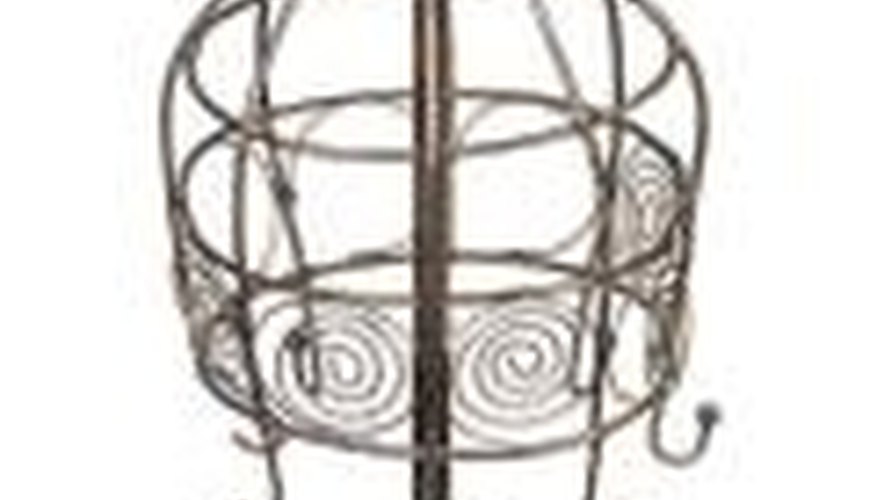Lampshade frames consist of metal wire that you must bend and solder together into the shape you want. Large lampshade frames can be expensive, particularly if the desired shape is unusual or non-standard. This makes learning how to create your own a good choice if you require a non-standard lampshade. Soldering is an easy skill that you can do safely in most dedicated work spaces with a few tools. Once you learn how to solder the pieces together, you can quickly begin designing the style of lampshade you want for your lamp projects.
- Lampshade frames consist of metal wire that you must bend and solder together into the shape you want.
- Once you learn how to solder the pieces together, you can quickly begin designing the style of lampshade you want for your lamp projects.
Draw your lampshade design on graph paper at full size. Use the graph to help you determine 90-degree joints. Draw the top plan and a plan for each differently sized side. Mark the locations of all your solder points. The top plan should include a center ring that is 1/2-inch around. Use a dime as a circle template and trace around the outside. The ring will be at the center and frame arms will radiate to each side of the shade.
Make a second hand jig. Drill a hole in the handle of several wood clothespins. Screw two of the clothespins 6 inches apart on the 2-inch side of a piece of the scrap 2-by-4 board using a screwdriver. The clothespins' mouths should be upright when the board is flat on the work table. This jig will act as a second set of hands to hold your wire while you solder. Set aside other clothespins and screws in case you need to add more to adapt your jig for your frame design.
Bend 14-gauge galvanized steel wire into your circle shape. Cut the wire even with the beginning of the circle using wire cutters. File both ends at 90-degree angles with a flat metal file so they are flat to each other. Bend the wire more until the ends line up and touch. Hold the ring with needle nose pliers and use sandpaper to sand the area around the joint clean. Position the ring with the joint side up in a clothespin without touching the ring with your fingers. The oils from your fingers can prevent the solder from sticking to the wire.
- Drill a hole in the handle of several wood clothespins.
- Hold the ring with needle nose pliers and use sandpaper to sand the area around the joint clean.
Place a large aluminum roasting pan with 2 inches of water nearby. Disposable roasting pans work well for this project.
Plug in and heat up your soldering gun. Coat both sides of the ring wire joint with flux. Flux is a liquid or gel-like substance that helps solder attach to metal. Touch the metal tip of the gun to the wires at the joint with one hand. Hold a spool of solder in the other hand with the end unrolled and close to the wires. When the wires get hot (red), touch the solder to the joint. The solder should melt and flow into the joint. Lift the solder roll away and remove the gun from touching the metal.
- Place a large aluminum roasting pan with 2 inches of water nearby.
- Hold a spool of solder in the other hand with the end unrolled and close to the wires.
Grasp the hot metal ring using your needle nose pliers. Open the clothespin mouth and dip the ring in the water to cool it off. Set the ring aside. Measure, cut, bend and shape each wire piece of one side. Add a third clothespin to an adjacent side of your jig if you are making 90-degree corners. File the ends flat and sand close to the joints. Position the pieces in your jig so you can solder each joint. Douse each soldered piece in the water bath. Wear a kitchen mitt if you need to carry your frame while it is hot using your hand and the pliers.
- Grasp the hot metal ring using your needle nose pliers.
- Open the clothespin mouth and dip the ring in the water to cool it off.
Make two opposing sides first for square or rectangular frames. Join the frames by soldering the bottom first. Clamp the top of the frame to small wood dowels to hold the frame the correct distance apart. Use clothespins to clamp the dowel and metal wire together easily. When adding a joint close to a soldered joint, only heat up the new metal wire fully since you don't want the existing joint to re-melt. Heat up the existing joint after the new metal wire end is hot. Hold the solder against the joint and pull the gun back as soon as the solder starts to flow.
- Make two opposing sides first for square or rectangular frames.
- Clamp the top of the frame to small wood dowels to hold the frame the correct distance apart.
Solder the top two wires to complete the perimeter of the shade. Turn your shade upside down. Place the ring in the center and cut and fit four wires attaching to each side. Solder the ring and four wires together first and then attach the top to the frame by soldering each of the top wires to the existing sides of the top of the frame. Douse and dry your frame completely.
TIP
Soldering is a skill that gets better with practice. After working on a few pieces you will develop your own tricks to soldering your joints. Spray paint your frame with metallic paint for a uniform color.
WARNING
A soldering gun has a tip that gets very hot. Take care to keep the gun on the stand and facing away from you when not in use.
